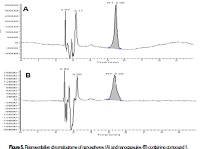Development and validation of an HPLC method for the quantification of a cytotoxic dihydropyranoxanthone in biodegradable nanoparticles
Keywords:
dihydropyranoxanthone, HPLC, polymeric nanoparticles, xanthonesAbstract
3,4-dihydro-12-hydroxy-2,2-dimethyl-2H,6H-pyrano[3,2-b]xanthen-6-one (compound 1) is a cytotoxic dihydropyranoxanthone exhibiting antiproliferative effects, inducing S-phase cell cycle arrest, and increasing the percentage of apoptotic cells in leukemia cell lines. Nevertheless, the poor aqueous solubility of compound 1 is a major drawback not only for its potential use in therapy but even for the in vitro assessment of its biological activity. Polymeric nanoparticles formulations were developed as potential carriers to overcome problems related with low water solubility of compound 1. The objective of this work was to develop and validate a specific, sensitive and simple HPLC method for the quantitative analysis of the prenylated xanthone (compound 1), which was entrapped in PLGA nanoparticles for the first time. Chromatographic separation was performed with a reversed-phase C18 column, using methanol: water (85:15, v/v) containing 1 % (v/v) acetic acid as a mobile phase at a flow rate of 1 ml/min and quantification was made by UV detection at 254 nm. The isocratic system required 10 minutes of chromatographic run. The method was shown to be linear (r> 0.999) over the concentration range of 0.50-3.00 µg/ml and precise at the intra-day and inter-day levels as reflected by the relative standard deviation values (lower than 1.5% and 1.6%, respectively). The mean recovery ranged from 97.53 to 104.28 % (RSD: 0.027%) and from 98.49 to 101.81% (RSD: 0.019 %) for nanospheres and nanocapsules, respectively. A simple, linear, sensitive, accurate, and precise HPLC method suitable for the quantification of compound 1 incorporated in polymeric nanoparticles was developed and validated.
References
Pinto MMM, Castanheiro RAP. Synthesis of prenylated xanthones: An overview. Curr Org Chem. 2009; 13: 1215-1240. http://www.benthamscience.com/coc/contabs/coc13-12.htm#6
. Palmeira A, Paiva A, Sousa E, Seca H, Almeida G M, Lima RT, Fernandes MX, Pinto M, Vasconcelos MH. Insights into the in vitro antitumor mechanism of action of a new pyranoxanthone. Chem Biol Drug Des. 2010; 76: 43-58. http://www.ncbi.nlm.nih.gov/pubmed/20456373
. Paiva AM, Sousa ME, Camões A, Nascimento MSJ, Pinto M. Prenylated xanthones: antiproliferative effects and enhancement of the growth inhibitory action of 4-hydroxytamoxifen in estrogen receptor-positive breast cancer cell line. Med Chem Res. 2011; 21: 552-558. http://link.springer.com/content/pdf/10.1007/s00044-011-9562-z
. D’Mello SR, Das SK, Das NG. Polymeric Nanoparticles for Small-Molecule Drugs: Biodegradation of Polymers and Fabrication of Nanoparticles. In: Pathak Y, Thassu D (ed) Drug Delivery Nanoparticles Formulation and Characterization, 1st edn. Informa Healthcare: New York; 2009. p. 16-34.
. Duncan R, Gaspar R. Nanomedicine(s) under the Microscope. Mol Pharm. 2011; 8: 2101-2141. http://pubs.acs.org/doi/abs/10.1021/mp200394t
. Panyam J, Labhasetwar V. Biodegradable nanoparticles for drug and gene delivery to cells and tissue. Adv Drug Del Rev. 2003; 55: 329-347. http://www.ncbi.nlm.nih.gov/pubmed/12628320
. Teixeira M, Cerqueira F, Barbosa CM, Nascimento SJ, Pinto M. Improvement of the inhibitory effect of xanthones on NO production by encapsulation in PLGA nanocapsules. J Drug Target. 2005; 13: 129-135. http://www.ncbi.nlm.nih.gov/pubmed/15823964
. Teixeira M, Alonso M J, Pinto MMM, Barbosa CM. Development and characterization of PLGA nanospheres and nanocapsules containing xanthone and 3-methoxyxanthone. Eur J Pharm Biopharm. 2005; 59: 491-500. http://www.ncbi.nlm.nih.gov/pubmed/15760730
. Fessi H. Procédé de préparation de sytémes colloidaux dispersibles d'une substance, sous forme de nanoparticules. French patent No. 2608988, 1988.
. Bernardi A, Zilberstein A, Jäger E, Campos MM, Morrone FB, Calixto JB, Pohlmann AR, Guterres SS, Battastini AMO. Effects of indomethacin-loaded nanocapsules in experimental models of inflammation in rats. Br J Pharmacol. 2009; 158: 1104-1111. http://www.ncbi.nlm.nih.gov/pubmed/19422380
. Guidelines Q2(R1) Validation of Analytical Procedures: Text and Methodology ICH 2005; pp 1-15.
. Convention, U. S. P., USP 29/NF24.Validation of Compendial Methods, Section (1225). Rockville, Maryland, USA, 2005; pp 3050-3052.
Teixeira M, Afonso C, Pinto MMM, Barbosa CM. A Validated HPLC Method for the Assay of Xanthone and 3-Methoxyxanthone in PLGA Nanocapsules. J Chromatogr Sci. 2003; 41: 371-376. http://www.ncbi.nlm.nih.gov/pubmed/12908954
. Teixeira M, Afonso C, Pinto MMM, Barbosa CM. Development and Validation of an HPLC Method for the Quantitation of 1,3-Dihydroxy-2-methylxanthone in Biodegradable Nanoparticles. J Chromatogr Sci. 2008; 46: 472-478. http://www.ncbi.nlm.nih.gov/pubmed/18647465
. Sousa ME, Afonso C, Pinto, MMM. Quantitative Analysis of Kielcorins in Biomimetic Synthesis by Liquid Chromatography/UV Detection. J Liq Chromatogr RT. 2003; 26:29 - 41. http://www.tandfonline.com/doi/abs/10.1081/JLC-120017150?journalCode=ljlc20
. LoBrutto R, Patel T. Method Validation. In: LoBrutto R, Patel T (eds) HPLC for Pharmaceutical Scientists, Wiley, New York; 2007. p. 455-502.





